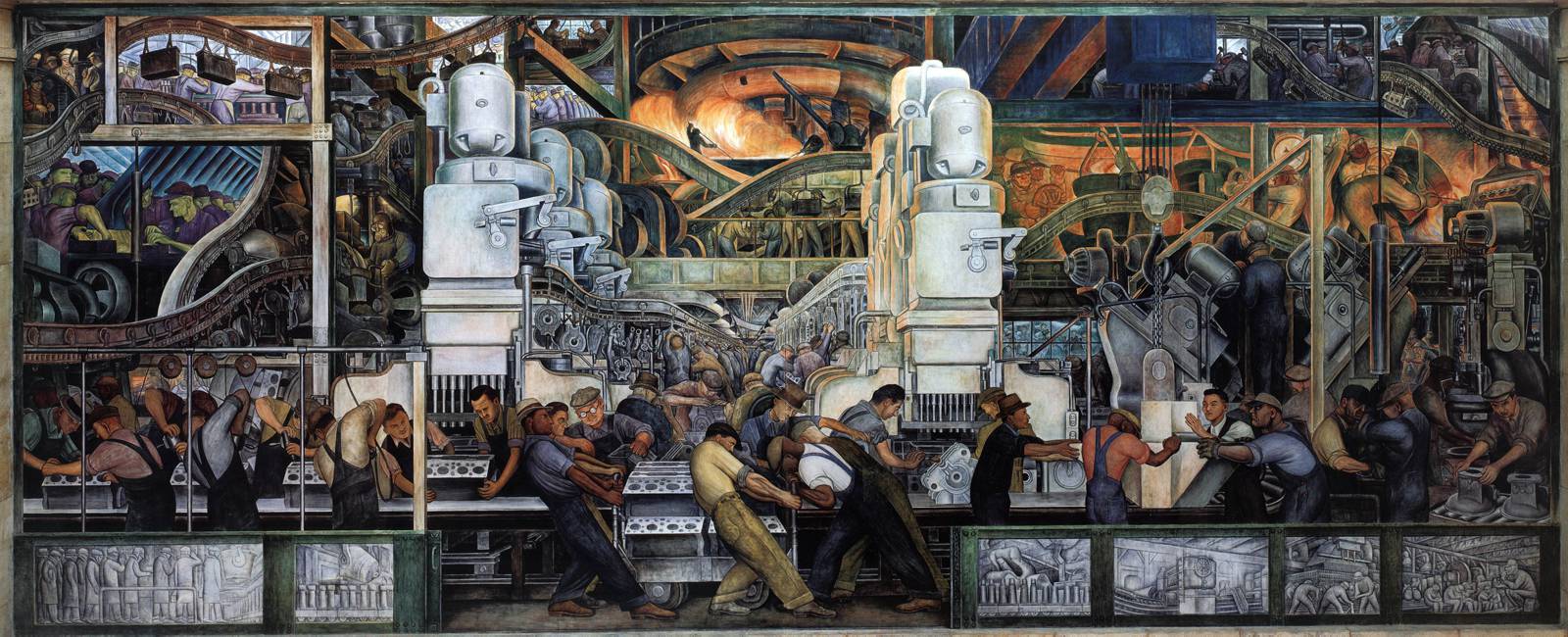DetroitDiego Rivera’s Detroit IndustryA Communist’s Homage to Capitalism
DetroitDiego Rivera’s Detroit IndustryA Communist’s Homage to Capitalism
There are some phenomena that you just have to experience in person to understand what all the hype is about. Mexican muralist Diego Rivera’s Detroit Industry fresco cycle is one of them. It’s worth the trip to Detroit if for no other reason than to stand in the Rivera Court at the Detroit Institute of Arts (DIA) and revel in his genius.

Considered by many, including Rivera himself, to be his greatest work, Detroit Industry was commissioned by William Valentiner, the visionary director of the DIA at the time, with backing from DIA patron Edsel Ford, Henry Ford’s son and heir, and unenthusiastic approval from the Detroit Arts Commission. The only request was that the murals address the history of Detroit and the development of industry.
Rivera and spouse Frida Kahlo arrived in Detroit in April 1932 to begin the preparatory work, spending months at the Ford Motor Company’s River Rouge factory and other industrial sites, taking photographs and making sketches. The work began in July, with his assistants preparing the plaster walls but Rivera himself doing all the painting.
When the 27 fresco panels that comprise Detroit Industry were opened for public viewing in late March 1933, the outcry was immediate. A front-page editorial in the Detroit News characterized the murals as “psychologically erroneous, coarse in conception, and to many women observers, foolishly vulgar.” City Councilman William P. Bradley called for the murals to be “washed from the walls.” Clergy denounced the work, particularly a panel called “Vaccination” that they interpreted as a gross caricature of the nativity—a child being inoculated by a doctor and a nurse, with animals in the foreground and three scientists hovering in the background.
The controversy spread like fire. Days after the opening, a New York Times article, “Detroit in Furor over Rivera Art,” reported that “the murals are being attacked by one faction as ‘communistic’ and ‘irreligious.’ … Forces headed by Dr. Valentiner deny that the frescoes are anything but the work of a great artist, and are making strenuous efforts to prevent the whitewashing or destruction of the paintings by official order.”
Amusingly, one consequence of the denunciation was a dramatic increase in the flow of visitors to the DIA. The Sunday after the opening, visitors flocked to the museum. “10,000 Jam Art Institute to See Disputed Murals,” read the headline in the Detroit Times. Some art historians, including Graham W.J. Beal, DIA director from 1999 to 2015, believe that Edsel Ford actually stoked the controversy to drum up traffic and build public support for the museum. (See Beal’s article “Mutual Admiration, Mutual Exploitation: Rivera, Ford and the Detroit Industry Murals” in the Berkeley Review of Latin American Studies.)
Ford, who was chair of the Detroit Arts Commission at the time, initially kept a low profile but finally came forward in support of the murals. According to Beal, a few days before the commission endorsed the murals, Ford said, “I am thoroughly convinced that the day will come when Detroit will be proud to have this work in its midst. In the years to come, they will be ranked among the truly great art treasures of America.”
And indeed they are. Over half a million visitors annually come to stand in awe of Rivera’s masterpiece, designated a National Historic Landmark in 2014. “There’s a lovely irony,” wrote Tom L. Freudenheim in the Wall Street Journal long before the landmark designation, “in contemplating that this work by the 20th century’s most important Mexican artist remains one of America’s most significant monuments to itself.”
When Detroit declared bankruptcy in 2013, the DIA came under threat because the museum was owned by the city, and the city’s creditors were clamoring for the DIA’s treasures to be sold to pay off the city’s debts. The Rivera murals themselves were never actually at risk because they are part of the building, but they became the symbol of the DIA’s fight for its life.
“There’s a lovely irony in contemplating that this work by the 20th century’s most important Mexican artist remains one of America’s most significant monuments to itself.”
To save the museum, Beal and DIA Board Chair Eugene Gargaro Jr. went to work behind the scenes, meeting with state officials, private donors, and foundations to cobble together a rescue plan that came to be known as "the grand bargain." The coalition raised $816 million to bail out the city's public employee pension fund. In return, the City of Detroit transferred ownership of the museum to a nonprofit to prevent such a threat from ever happening again.
That was in late 2014. The following spring, the DIA opened a new exhibit, “Diego Rivera and Frida Kahlo in Detroit,” featuring 70 works by both artists, including eight rarely shown, large-size charcoal studies Rivera made for the fresco panels. The exhibition had been in the planning stages for years but was put on hold during the bankruptcy crisis. It was the last exhibition Beal would mount before stepping down as president and CEO of the DIA, having seen the museum safely through the crisis.